Wall 1: World War II Starts
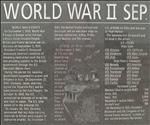
On September 1, 1939
World War II began in Europe when German military forces invaded Poland.
Britain and France declared war on Germany on September 3, 1939. President Franklin D.
Roosevelt announced America’s intention of remaining neutral but soon the
U.S. was providing supplies to the British government through the U.S. Merchant
Marine fleet.
During this period the Japanese government expanded its power and influence in Asia.
On September 27, 1940, Germany, Japan, and Italy signed the
Tripartite Pact and became known as the
Axis Powers. On October 16, 1940, the U.S. announced an embargo of scrap
iron and steel to Japan. The U.S. later added oil to the embargo list.
On January 30, 1941, Germany announced that any ships carrying materials to Britain
were subject to submarine attacks. By December 7, 1941, the United States had lost
one destroyer and six merchant ships to
German submarines, killing 39 Merchant Marines and 100 seamen.
Attack at Pearl Harbor
On December 7, 1941, at 7:55am the
Imperial Japanese Navy launched a surprise air attack on U.S. forces stationed
on the Hawaiian island of Oahu. They used a total of 360 airplanes to attack U.S.
airfields on Oahu and the ships at
Pearl Harbor.
The Japanese lost 29 aircraft and 63 dead in the attack.
U.S. Losses
Ships Sunk:
- USS Arizona USS California
- USS Oklahoma USS West Virginia
- USS Utah USS Oglala
- Ships Heavily Damaged:
- USS Nevada USS Honolulu
- USS Pennsylvania USS Helena
- USS Tennessee USS Cassin
- USS Maryland USS Shaw
- USS Raleigh USS Downes
- USS Curtiss USS Vestal
- Personnel Losses
- Marines killed in action (KIA) 108
- Army KIA 202
- Navy KIA 2,004
- Wounded in action (WIA) 1,347
Aircraft lost: 188
On December 8, 1941, President Roosevelt and the Congress of the United States declared,
“a state of war existed between the United States and the Japanese Empire.” On December
11, 1941, Germany and Italy declared war on the U.S. bringing the U.S. into the
war on the side of the Allies which included Great Britain, the Soviet Union, China,
Australia, and Canada.
Wall 2: The Philippine Islands Fall
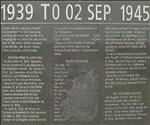
On December 8, 1941, Japanese forces bombed U.S. installations in the Philippine Islands. By January
2, 1942, the Japanese seized Manila with U.S. and Philippine forces retiring to
the Bataan Peninsula.
General Douglas
MacArthur, commander of all forces in the Philippines, was ordered to Australia.
General Jonathan Wainwright assumed command of U.S. and Filipino forces
in the Philippines on March 11, 1942.
On April 9, 1942, all forces on Bataan surrendered to the Japanese. On May 6, 1942,
the remaining troops on
Corregidor Island surrendered, giving the Japanese control of the Philippines.
U.S. Prisoners of War (POWs) 11,500
Filipino POWs 65,500
Approximately 22,000 American and Filipino POWs died on the “ Bataan Death March”
to internment camps.
Pacific Offensive
On May 7-8, 1942, U.S. Naval forces fought the Imperial Japanese Navy in the Battle of the Coral
Seas. Aircraft from both navies attacked their enemy without the ships of
either side firing at the other. American aircraft sank one Japanese carrier and
damaged two others. Japanese aircraft heavily damaged the USS Lexington, killing
543 sailors and 21 Marines.
A second and decisive naval battle was fought off
Midway Island on June 3, 1942. Aircraft from U.S. carriers attacked and
sank four Japanese carriers, resulting in the loss of 254 Japanese airplanes.
American losses totaled 150 aircraft, 40 Marines, and 349 sailors.
The Solomon Islands
On August 7, 1942, the 1st U.S. Marine Division landed on Guadalcanal. The 25th,
43rd, and Americal Army Divisions later joined this battle. After heavy
fighting U.S. forces seized the island on February 9, 1943. Between February andAugust
of 1943 the 1st Marine Division took Russell, New Georgia, and Rendova
Islands. The seizure of Bougainville on March 24, 1944, completed the campaign for
the Solomon Islands.
The U.S. Navy fought several fierce battles around the
Solomon Islands. The Navy lost 24 ships including the aircraft carriers
Hornet and Wasp, six heavy cruisers, and 14 destroyers.
U.S. Losses in the Solomons
- Marines KIA 1,042 WIA 2,894v
- Army KIA 650 WIA 1,289
- Navy KIA 3,816 WIA 1,817
Wall 3: U.S. Fights in North Africa
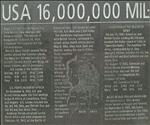
On November 8, 1942, U.S. and British forces made the first landings in North Africa at Casablanca,
Oran, and Algiers. U.S. troops included the 1st, 3rd, 9th,
34th, and 78th Infantry Divisions And the 1st and
2nd Armored Divisions.
American forces advanced across North Africa and were stopped on February 14, 1943
at the
Battle of Kasserine Pass. U.S. losses included 192 KIA, 624 WIA and 2,450
POWs.
The Americans regrouped and with British forces continued the attack across North
Africa and on May 8, 1943, they took Tunis and Bizerte, ending the war in Africa.
Total casualties for the Allied forces in the North African campaign were 66,000.
The conquest of North Africa freed the Allied forces to support the invasion of
Southern Europe.
Allies Invade the Island of Sicily
On July 10, 1943, American and British forces totaling 80,000 men invaded the Italian
island of Sicily
in “Operation
Husky”. The American 7th Army, commanded by
Lt. Gen. George S. Patton, included the 1st, 3rd
and 45th Infantry Divisions, 82nd Airborne Division and 2nd
Armored Division.
By August 17, 1943, American and British forces entered Messina, seizing Sicily
and over 100,000 prisoners. This completed the conquest of Sicily.
U.S. Casualties in Sicily
- Army KIA 2,062 WIA 7,137
- Navy KIA 546 WIA 484
Allies Invade Italian Mainland
On September 3, 1943, British forces landed at Reggio and Taranto. On September
8, 1943, the Italian government surrendered to the Allies. German forces established
a battle line in central Italy and were joined by some rebel Italian forces.
On September 9, 1943, American forces of the 5th Army landed near Salerno. This was “ Operation Avalanche”.
It included forces from the 1st, 3rd, 34th, 36th,
and 45th Infantry Divisions and the 1st Armored Division.
The drive to take Rome was briefly stalled at
Monte Cassino by German forces on January 15, 1944.
On January 22, 1944, American forces from the 1st, 3rd and
45th Infantry Divisions landed behind enemy lines at the port of Anzio in response to German resistance
at Monte Cassino.
After heavy fighting, Anzio invasion forces linked up with the 34th,
36th, 88th, and 89th Infantry Divisions, opening
the road to Rome. Troops of the 88th Infantry Division entered Rome on June 4, 1944. From the
Salerno and Anzio landings, to the capture of Rome, U.S. forces suffered 107,144
casualties.
Wall 4: U.S. in the South Pacific
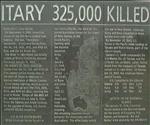
While American forces fought in the Central Pacific, the 32nd Infantry
Division joined Australian troops on the island of
New Guinea, in the South Pacific, clashing with the Imperial Japanese Army.
By January 23, 1944, they had seized the cities of Buna and Gona.
On April 22, 1944, Americans took
Hollandia, trapping the remaining Japanese forces between the Americans
and the Australians. This effectively ended the war in New Guinea. American Army
and Navy casualties in these battles were over 3,000.
By November 20, 1943, U.S. forces in the Pacific made landings at Tarawa and Makin Islands, part
of the Gilbert
Islands.
General J.C. Smith commanded the 2nd Marine Division at Tarawa, and the
27th Infantry Division at Makin. Later, forces freed from the conquest
of Tarawa moved on to take
Betio. On November 23, 1943, the American forces seized Tarawa.
U.S. Casualties in the Gilberts
- Marine KIA 950 WIA 2,292
- Navy KIA 724 WIA 735
- Army KIA 66 WIA 152
Attack on the Marshall Islands
On January 31, 1944, American forces landed in the
Marshall Islands on the islands of Kwajalein, Roi, Namur, and Eniwetok.
Roi and Namur were seized by the 4th Marine Division on February 2, 1944.
On February 5, 1944, the 7th Infantry Division seized the island of Kwajalein.
Marine and Army forces combined to take
Eniwetok Island.
On February 20, 1944, the U.S. forces secured the
Marshall Islands.
U.S. Casualties in Marshalls
- Marine KIA 567 WIA 1,057
- Navy KIA 267 WIA 1,104
- Army KIA 200 WIA 793
Wall 5: South Asian Front
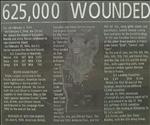
While combat continued in the Pacific and Europe, American forces were fighting
in Burma under
Lt. General Joseph Stillwell. His forces built the
Ledo Road to transport war supplies to their Chinese allies in the fight
against Japanese forces. American, British, and Chinese forces participated in this
campaign from 1942 to the end of the war.
Invasion of Western Europe
On June 6, 1944, American, British, Canadian and Allied forces crossed the English Channel by ship
from Great Britain in “
Operation Overlord”. They landed on five beaches in France.
American forces landed at beaches code named “Omaha” and “Utah”. American forces
included the First Army (1st, 4th, and 29th Infantry
Divisions). The 82nd and 101st Airborne Divisions, and the
91st Infantry Division, using glider planes and parachutes, landed behind
enemy lines just prior to the beach landings.
British and Canadian forces landed at the other three beaches in France code names
“Gold”, “Sword”, and “Juno”.
By the end of June, the 5th, 8th, 9th, 28th,
30th, 35th, 79th, and 83rd Infantry
Divisions, and the 2nd, 3rd, 4th and 5th
Armored Divisions, with supporting units, were joined in combat against German forces
in France.
U.S. Landing Casualties
Within the first 30 days of the landings, Allied forces suffered 62,000 casualties.
On July 13, 1944, Americans attacked the key defense point of St. Lo, France and seized it
on July 17. The U.S. suffered 10,076 casualties between the landing at Normandy to St. Lo’s
capture.
U.S. forces, under
Gen. Omar Bradley, with the 12th Army Group, fought major battles
at Falaise, Le Mans, and Argentan, in France. Free French forces occupied Paris on August 23, 1944, with
Americans arriving a day later.
American Allies and the 12th U.S. Army Group advanced into Belgium with
fierce fighting at Arnhem. The Allies suffered 30,000 casualties in battles from
St. Lo to Arnhem.
Wall 6: Fighting in the Pacific
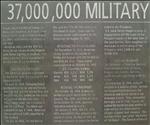
The Americans advance continued in the Pacific with the invasion of the Mariana Islands.
On June 15, 1944, following heavy bombardment by air and sea forces, the 2nd,
3rd, and 4th Marine Divisions and the 27th Infantry
Division landed on the island of
Saipan in the Mariana Chain. U.S. forces were under the command of the 5th
U.S. Fleet. The island was captured on July 9, 1944. American forces suffered 7,000
casualties in this invasion.
On July 21, 1944, the 3rd Marine Division and the 77th Infantry
Division landed on the island of
Guam. Guam and the Mariana Islands were secured by the Americans on August
10, 1944.
Attacking the
Palau Islands
On September 15, 1944, American forces landed on the islands of Peleliu and Anguar
with the 1st Marine Division and 85th Infantry Division these
islands were captured on October 14, 1944.
U.S. Casualties in Palau
- Marines KIA 1,252 WIA 5,274
- Army KIA 540 WIA 3,275
- Navy KIA 158 WIA 663
Retaking the Philippines
On October 20, 1944, Americans landed on
Leyte Island with the 1st Cavalry, 7th, 24th,
and 96th Infantry Divisions on December 25, 1944, Japanese resistance
ended on Leyte.
On January 9, 1945, the 6th, 37th, 40th, and 43rd
Infantry Divisions landed on the island of
Luzon. By May of 1945 all serious resistance to American forces ended in
the Philippines.
U.S. Naval forces fought a series of engagements off the coast of the Philippine
Islands at the same time of the land battles. Total casualties for Americans in
the retaking of the Philippines were 3,508 KIA and 10,000 WIA.
Victory in Europe
By December of 1944 the Western Front extended from Antwerp, Belgium and Aachen,
Germany South through Luxemburg to Metz, France.
On December 16, 1944, using 25 divisions in a surprise attack. German forces penetrated
between the American and British forces in the
Ardennes Forest. They surrounded Bastogne and St. Vith, France and pushed
the battle line back another 50 miles before the Allied counter-attacks stopped
their advance. This German attack was called “the
Battle of the Bulge”. The German offensive stalled and a month later the
Germans began withdrawing. The battle cost the Americans 4,138 KIA, 20,321 WIA,
and 15,946 MIA.
Wall 7: Germany

By March 6, 1945, U.S. and Allied troops pushed German forces back to the Rhine River in Germany.
Fierce battles occurred at Echternacht, Trier, and Rumagen in Germany. Allied troops
continued to gain ground in Western Europe.
By March 1945, German forces became trapped between the Americans and Allies in
the West and the
Soviet Allies in the East.
The Air War
The air war over Europe was one of the most extensive in history involving over
4 million sorties of American fighters and bombers.
The
U.S. Army Air Corps lost 79,265 men and 18,000 airplanes in Europe. Over
2,700,00 tons of explosives were dropped on Europe by 28,000 aircraft. These bombings
destroyed approximately 3,600,000 buildings and killed 300,000 Germans, hastening
the end of the war.
Germany Surrenders
By April 25, 1945, the Soviets had entered the Eastern parts of Berlin.
Adolph Hitler,
the Fuhrer (leader) of German forces and the German state, committed suicide on
May 1, 1945. Admiral
Karl Doenitz assumed command of German forces.
American troops stopped at the Elbe River in Germany on May 1, 1945, waiting for
the Soviet occupation of Berlin on May 2, 1945.
On May 7, 1945,
Admiral Hans-Georg von Friedeburg agreed to Germany’s unconditional surrender.
General
Dwight D. Eisenhower accepted for the Allies as Supreme Allied Commander.
At 11:01 p;m., May 8, 1945,
President Harry S. Truman announced “Victory
in Europe” of “V-E Day”.
Pacific War Continues
On February 19, 1945, American forces attacked Japanese forces on the island of
Iwo Jima.
The 4th and 5th Marine Divisions conducted the main assault.
By March 6, 1945, after heavy fighting, the Americans captured Iwo Jima. In this
battle 27 men received the
Medal of Honor, America’s highest award for bravery. This number was the
most awarded in any battle fought by U.S. forces.
U.S. Casualties on Iwo Jima
- Marines KIA 5,423 WIA 4,668
- Navy KIA 982 WIA 17,200
On April 1, 1945, U.S. forces commanded by
Lt. Gen. Simon Buckner, landed on
Okinawa Island with the 1st and 6th Marine Divisions
and the 7th, 96th, and 77th Infantry Divisions.
Japanese “Kamikaze”
aircraft designed to crash into U.S. ships, caused serious destruction to American
ships. Fierce fighting lasted on the island until the Japanese surrendered on June
21, 1945.
In lives and Naval damage, this was the costliest battle for Americans during the
war. Americans had 16,278 KIA and another 14,607 WIA in this battle. The U.S. Navy
had 30 ships sunk and 223 damaged.
Japan Surrenders
From June 5, 1945 to August 15, 1945, U.S. forces bombed the Japanese home islands.
Marine, Navy, and Army Air Corps aircraft played a critical role in attacking Japanese
bases and cities. Bombing attacks on the Japanese home islands caused approximately
330,000 killed, 476,000 injured, and 3,000,000 buildings damaged.
On August 6, 1945, the U.S. dropped the first
atomic bomb used in combat on the city of
Hiroshima. This killed 80,000 people, injured 37,000 and left 10,000
missing. Ten years later the number of deaths due to side effects from the bomb
climbed to approximately 140,000.
On August 9, 1945, an atomic bomb was dropped by the U.S. on Nagasaki,
Japan with approximately 40,000 killed, 6,000 injured, and 5,000 missing.
On August 14, 1945,
Emperor Hirohito announced Japan’s intention to surrender. On August 27,
1945, Japan formally surrendered to
Gen. Douglas MacArthur aboard the USS Missouri in Tokyo Bay, Japan.
Wall 8: World War II Ends

During World War II, 50 million people served in arms, including 16 million Americans.
Over 400,000 U.S. women served, including 76,000 nurses. Approximately 220 U.S.
women were killed in action.
U.S. Casualties by Service During World War II
KIA WIA
- Army 234,874 565,861*
- Navy 36,950 37,778
- Marines 19,733 67,207
- Coast Guard 574 955
- Merchant Marines 8,651 11,000
- *includes Army Air Corps
- Total War Deaths for all Countries During World War II:
- From 50 Allied armies 13,000,000
- From 9 Axis armies 4,000,000
- Civilians 20,000,000
Over 55 million people were injured and 3 million disappeared in the war thus ending
the deadliest conflict in history with a hope for world peace.